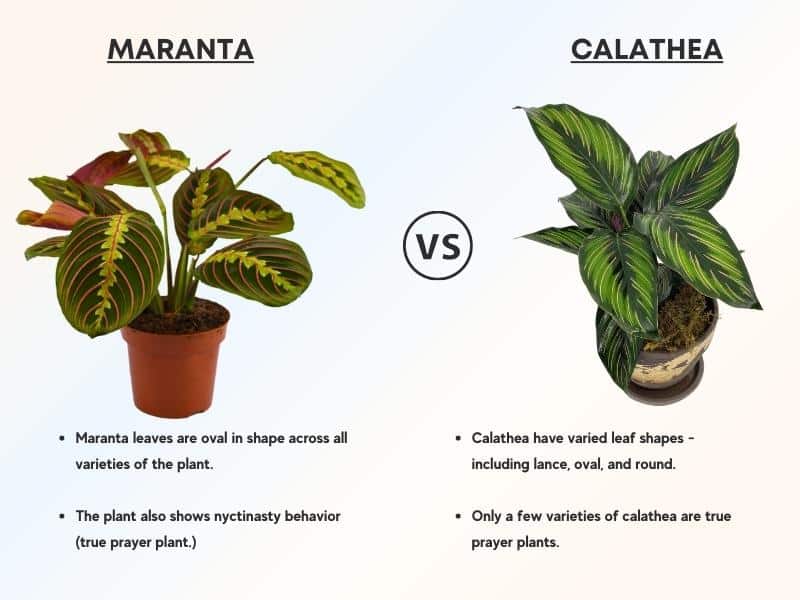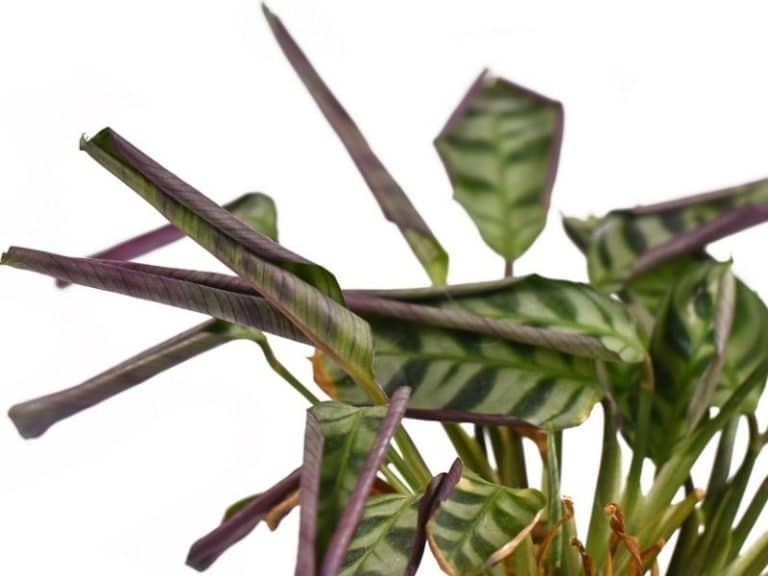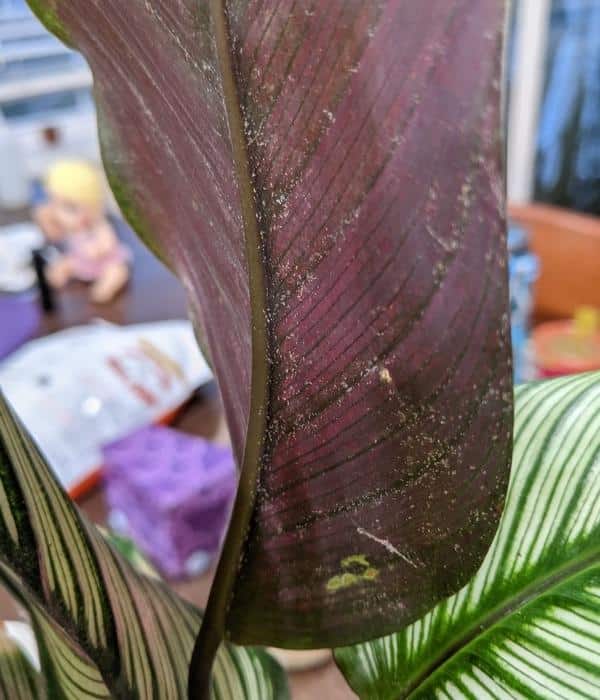Maranta vs Calathea (Prayer Plant) – Differences
Maranta and calathea stem from the same family – Marantaceae – but there are significant differences between the two plants. Vendors often mislabel these plants in garden stores so it is easy to believe you have a calathea yet you have a maranta. So, what’s the main difference between calatheas and marantas?
Maranta plants have oval-shaped leaves while calatheas have a variety of leaf shapes such as lanced, oval, and rounded. Another main difference is that all marantas are true prayer plants that perform nyctinasty (folding leaves at night) while only a few varieties of calathea show foliar nyctinasty.
Maranta and calathea are in different genera and are planted primarily for their beautiful foliage. However, marantas are the most distinguishable tropicals.
Are Calathea and Maranta the same?
Calathea and maranta are not the same species but they belong to the same family, Marantaceae. The two plants are of different genera and have several physiological and biological similarities and differences. The most popular maranta and calathea are Maranta leuconeura and Calathea Ornata, respectively.

Although calathea and maranta are popularly known as prayer plants, most varieties of calathea show little or no “praying” behavior. Marantas are the true prayer plants. Calathea and maranta are native to the tropical parts of Central and Latin America. They are both tropical understory plants that thrive in nearly the same environmental conditions. So, generally, calatheas are not Prayer plants.
The care basics are also pretty much the same, but I’d recommend maranta if you’re new to Prayer plants. Maranta is much more forgiving than calathea when it comes to tolerating the cold so it’ll thrive well if you live in cold regions.
If you can take proper care of maranta, you can learn from it and introduce calathea later in your plant collection. Not only are they easy to care for, but it is also difficult to mistake the leaves and patterns of maranta for those of calathea.
Unlike calathea, which are erect and grow like shrubs, maranta spreads the stems. Therefore, the marantas are less bushier and suitable for hanging baskets.
The spreading maranta leaves will hang beautifully and conspicuously in spacious hallways, in the sitting area, or in the place of wall art. Although you can also hang potted calathea, they offer great views when seated on flat surfaces.
Calathea vs Maranta: Differences
Most people refer to both plants as Prayer plants. Although that is understandable, it is not entirely true. True nyctinasty, for instance, occurs only in maranta and not in all varieties calathea. In other words, marantas actively fold and open up their leaves in response to daylight. Therefore, marantas are true prayer plants, and calatheas aren’t.
Here are the major differences between calathea and maranta plants:
| Calathea | Maranta |
| Calatehas show slight or no nyctinasty depending on the variety. | Marathas exhibit full nyctinasty. |
| Calathea leaves vary in shape from elliptical, oval, and round. | Maranta leaves are oval and velvety. |
| Calatheas are less cold-tolerant but fairly easy to care for. | Marantas are more tolerant of cold. |
| Carefully painted in bright and bold colors, with striking patterns. | Distinct colored midrib and vein in shades of green and red. |
| Calatheas are shrubby and grow straight. | Marantas are less bushy with spreading stems. |
| Calathea has 60 varieties | Maranta has 14 – 20 varieties. |
| Propagation of calathea is through root division | Maranta can be propagated through root division, stem cuttings, and seeding. |
Nyctinasty
Nyctinastic leaf movement is the major difference between maranta and calathea. All marantas open their leaves flat during the day and close them at night as if they are praying.
See the timelapse video below of my maranta over 24 hours.
While some varieties of calathea respond to the intensity of daylight, it is worth noting that not all of them do.
For example, while calathea Lancifolia and calathea Roseopicta raise and lower their leaves, you will notice little to no nyctinasty in Makoyana and calathea Freddie. In contrast, all the 20 varieties of maranta are Prayer plants.
Leaf shape and texture
Another easy way to distinguish calathea from maranta is by looking at the shape of the leaves. All varieties of maranta have oval leaves, while calathea leaves vary from elliptical, oval, round, and lance, depending on the variety.
The texture of the leaves will also differ significantly. Marantas have lots of hair on their leaves, giving them a more velvety feel than calathea. Nevertheless, they both have a waxy appearance on the underside of the leaves.
Leaf variegation
Apart from nyctinasty and leaf shape and texture, you will distinguish maranta from calathea by looking at the leaf variegations. Since you may not be around to see the effect of light on the Prayer plants from dawn to dusk, the striking leaf colors and patterns offer sufficient evidence at a glance.
Maranta’s midrib, veins, and leaf blades are very different from calathea. The stripes and patterns on maranta leaves are also bold and splotchy.
They are distinctive and occur in shades of green and red or white markings. On the other hand, calathea leaf variegations show diverse patterns that make specific varieties suitable for typical indoor decorations.
Foliage color
Marantas have glossy dark-green leaves while calathea have bright yellow, white, rose, and even olive colors. Most importantly, you can identify maranta by their red-colored veins and a central light-green section of the leaves that goes up to the center.
The undersides of both plants have purple shades, but for calathea, the purple is much bolder. For maranta, the bottom appears reddish-purple. These fancy leaves make maranta and calathea an excellent plant for your home garden or indoor decorations.
Growth trends
Maranta leaves are vine-like, while calathea leaves are upright. In other words, maranta leaves spread and flow around the container to about 18 inches. Vertically, maranta grows to a height of 10 to 12 inches.
You can grow maranta in a container or as a ground cover. On the contrary, calathea are erect and grow up to two feet tall. Calathea growth is also relatively slow and will stop growing after maturing. Unlike maranta leaves, calathea leaves are stiff and extend only six inches away from the main plant.
Species and mode of propagation
Other differences between calathea and maranta are the number of species in each genus and the propagation methods. Botanists have documented about 60 varieties of calathea and between 14 and 20 types of maranta. Meanwhile, maranta offers three options of propagation and calathea only one.
You can propagate maranta through root division during repotting, stem cutting, and planting seeds. You can propagate calathea only through root division.
Here’s a summary of the differences between calathea and maranta:
Another Prayer plant look-alike that is commonly confused with calathea is Ctenanthe. For example, many stores refer to Ctenanthe Setosa, a variety of Ctenanthe, as Calathea Setosa, which is not true. These houseplants also belong to the Marantaceae family and are grown primarily for their beautiful variegated foliage.
Confusing maranta for calathea and calathea for Ctenanthe can bring unwanted results to your house or home garden. For instance, wrongful care can result in drooping, wilting, and even death to your plant.




